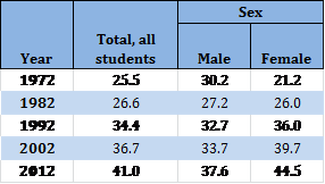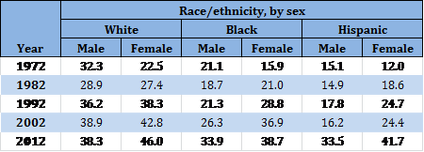 Enrollment rates in US colleges, ages 18-24 Enrollment rates in US colleges, ages 18-24 Rebecca wrote yesterday (Where the Boys Are) about the large swings in the aggregate gender of American university students. For several decades now, women have been attending college at higher (and faster increasing) rates than men, leading to a current “national student body” that is approaching 60% female. I had a hunch that a deeper dive into the demographics would show some interesting trends, and I was (sort of) right. First, Rebecca’s concluding assertion, that “young men are disappearing in droves from campuses across the nation,” is somewhat misleading. Young men aren’t disappearing from college campuses as much as they are being crowded out by the growing numbers of women. Men are, in fact, attending college in higher rates than ever before. Per the National Center for Education Statistics, attendance by men aged 18-24 at institutions of higher learning is near its all-time highs [for simplicity’s sake, all of the data from here on out comes from that same age set]. After falling during the 1970s, attendance was in the mid 20%’s around 1980 and rose to a record 39.1% in 2011 before falling slightly in 2012 (the most recently available data). Those increases, however, are dwarfed by the staggering gains made by women over the same period. In 1980, about 25% of women attended some college, a rate that had already grown substantially since the late 1960s. By 1990, that attendance rate had risen to 32%, a gain that largely tracked male progress over the same time period. Over the next decade, however, women gained much faster than men, reaching 38.4% by 2000 and peaking at 44.9% in 2011. I also had a second theory: that the changes were impacting different racial groups unevenly. Namely, I had a suspicion that the massive increases in women’s college attendance were fueled disproportionately by black and Hispanic students while white and Asian students largely maintained their balances.  Attendance rates at US colleges by race/ethnicity and sex Attendance rates at US colleges by race/ethnicity and sex Turns out, that is pretty much the opposite of true. Black and Hispanic men, while still attending college in rates that did not increase as fast as their female counterparts, made gains at rates that were closer to the women (the data doesn’t break out Asian attendees by sex). It’s the white men who really lagged. The increase in white women’s attendance rates represented about 24% of their population. For black women, that increase was about 23%, and Hispanic women saw a move of nearly 30% of their numbers into college. In the same period, the increase in attendance of men represents nearly 13% of black men, and nearly 20% of Hispanics, but only 6% of whites. In the last 20 years, the portion of white men attending college has barely budged, while rates of black and Hispanic men attending college have risen substantially. The story, therefore, is kind of the opposite of most economic stories: white men are the big losers (although, it should be noted, they still attend college at higher rates than either black or Hispanic men). All of this leads to a pretty obvious set of questions, most of which start with “Why.” My suspicion is that overall male/female ratios are due in part to better employment prospects for non-college men than women, mostly in fields that still rely heavily on physical labor. Anecdotally, there are not a lot of women on the thousand or so (it seems) reality TV shows that highlight commercial fishing, crabbing, gold mining and logging. The biggest US economic success story of the last decade, the explosion of onshore oil and gas production, stands as evidence that there are still fields that offer superior prospects to an 18-year-old boy than to an 18-year-old girl. I also think that some of it is a cultural result of the things that teenage boys and girls are taught to value. It is still, in at least a significant portion of places, socially more acceptable for girls to prioritize academic achievement than it is for boys to do the same. The racial and ethnic differences may be somewhat harder to crack. On the one hand, the bigger increases among black and Hispanic students might simply be due to catching up to whites after starting at a much lower baseline. It could be that there is just a maximum efficient level of college attendance, and white males have reached it, while males of other races are just now approaching it. There is, however, at least one piece of data that says the differences are more deeply cultural than that: Asian-Americans attend college at a rate almost 50% higher than that of other Americans. That is, frankly, a staggering data point, and one that is worthy of a much deeper dive than I am prepared to do here. I’ll leave that to another Misfit. ;-)
0 Comments
Leave a Reply. |
MisfitsJust a gaggle of people from all over who have similar interests and loud opinions mixed with a dose of humor. We met on Twitter. Archives
January 2024
|
 RSS Feed
RSS Feed